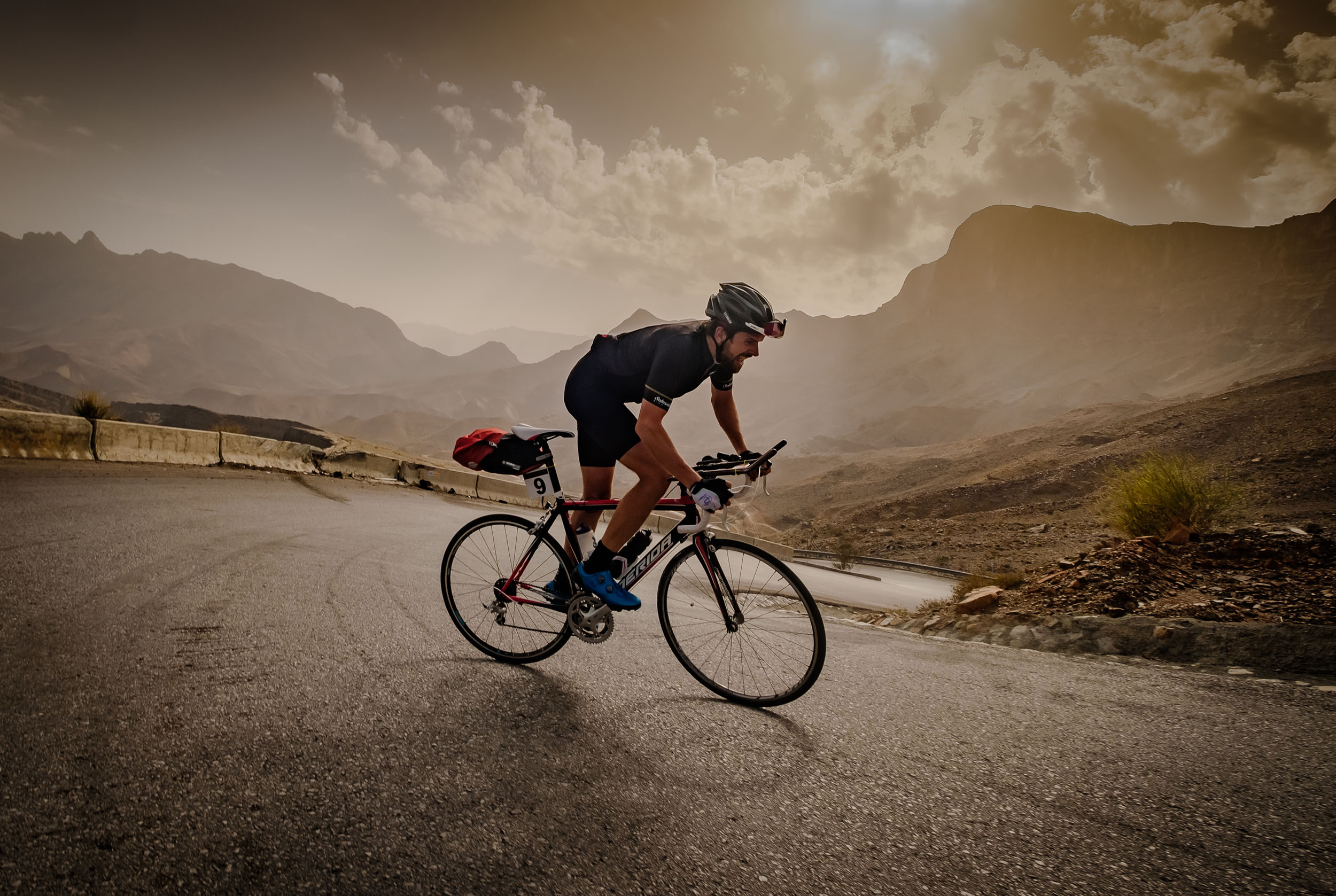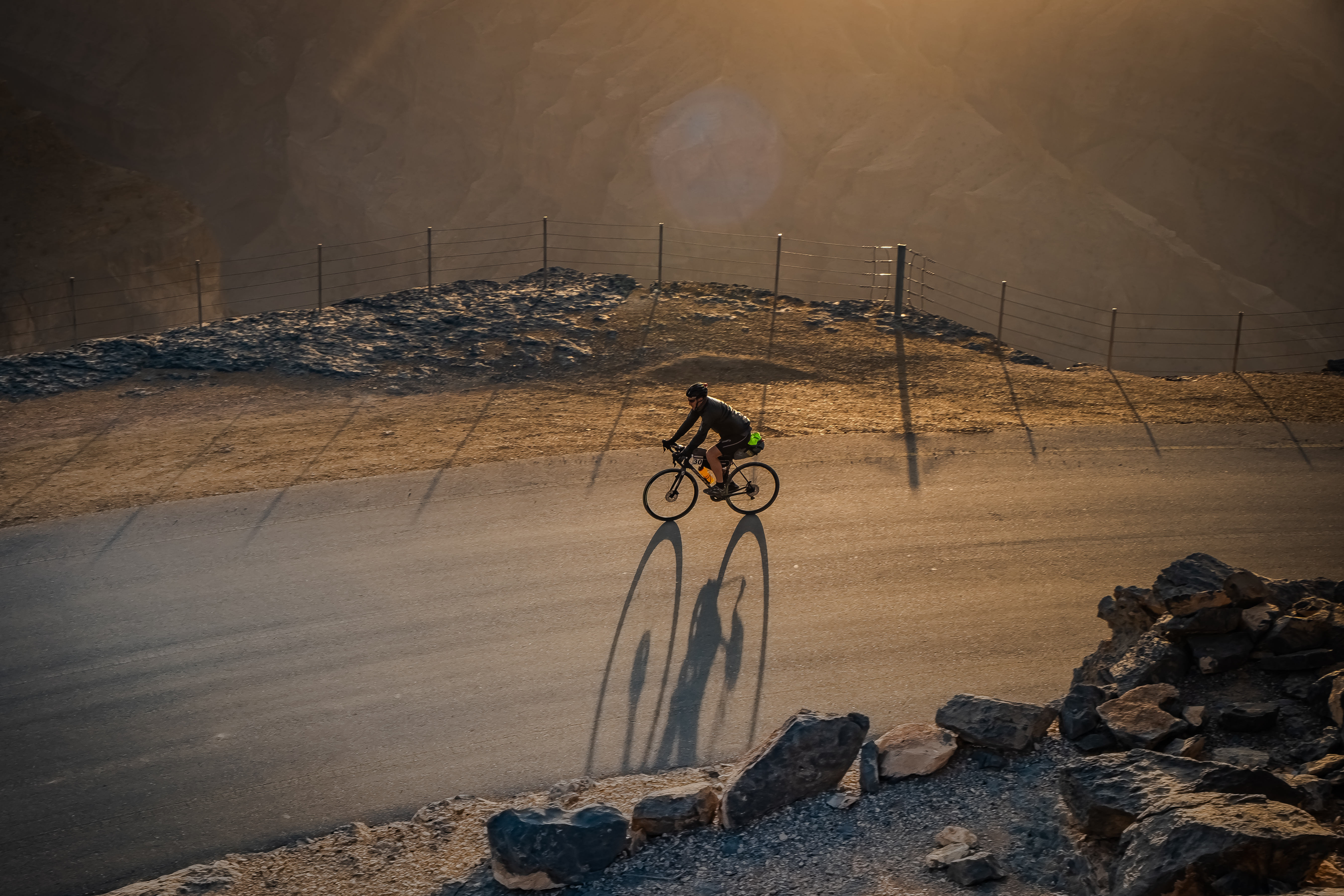Chasing a band of ultra cyclists through the deserts and mountains of Oman was the latest mission for Steve Thomas and his X system cameras.
Maybe it comes with getting older – thinking about things more that is. It was late night on the outskirts of Muscat, the imposing capital city of Oman, and I was about to start shooting the Bikingman Oman Ultra race, a 1050-km unsupported bike-packing race through the deserts and mountains of this sandy Arabian outpost.
Oman has become something of a hot travel destination in recent times, in so many ways. From a cycling angle it’s hit the headlines for a while, as the venue for the annual Tour of Oman pro stage race, although I have to admit that I hadn’t really seen enough coverage to what the country was all about.
In a few hours time (at a startling 3am in the morning) around 90 cyclists from around the world would set off into the wilds of Oman, all carrying more or less what they needed for the duration of the race, and to ride or race solo until they returned back to Muscat. For the winner that would be a shimmering 38-hours, while the tail enders would finish up in in 109-hours, just under the 5-day time limit for the event.
Although I’ d travelled and raced the world (and shot bike races) for much of my life, this was something a bit different for me. I had no map and no real knowledge of what was going on, or of how things would work. To say that I was a little apprehensive was an understatement, especially when the car keys were handed over, and nothing else.
There are no route markers, no race entourage, and the riders would be so extremely spread out that it would be hard to track and shoot them. Apps seemed to be the answer – teamed with GPS, where the riders could be tracked the whole way. Great, or at least it would be if I’d got any idea of how to find and work the damn thing at short notice. Add in the fact that my iPhone battery had died, and wouldn’t hold a charge, and I did kind of start to get the jitters.
As luck would have it a French photographer asked to tag along with me. He also had a working phone and was tech savvy enough to figure out the tracking situation; phew, it was game on.
My arsenal for the event consisted of an X-T2, X-T1, 18mm, 10-24mm, 18-55mm and a 55-200mm lens, plus as many batteries as I had and a small Nissin i140 flash, all of which would get used during the event – although the flash was only for a few minutes at the start.
I had an idea of what I wanted to achieve on the image front, which did conflict some with my cohort; but in reality neither of us knew what to expect, as it was a new concept and region to both of us.
As we set off the race was neutralised and escorted by the local police, which was great for the riders, but meant that we were stuck behind, meaning that the hoped for night riding group shots – with streaming lights was a no go.
We had all of our gear with us, as neither of us knew just how long we’d be out there, or if and where we might catch 20 winks or so. I’d heard about Jebel Shams, a high plateau and peak in the Hajar Mountains, which is often pitched as the regional Grand Canyon. This would be reached after 350km, and was the first of 2 checkpoints on the race. Sunset images were leaping out of my mind, followed by a few hours of sleep and then sunrise pics.
As things panned out that part of the plan fell vaguely into place, although we did make 2-3 runs up and down the slopes of the mountain, maxing out our potential in shooting the riders.
By the time we reached here the leader had already passed, which came as a shock to both of is. The mid-day light was as harsh as you’d expect of the desert, but the rippled backdrop of the Hajar peaks made for some amazing contrasts.
I’d stuck mostly with the 18-55mm lens, which really is an amazing piece of kit. On the close up hairpin bend images I switched to the 10-24, to give more scale to the setting. As the sun dropped I swapped to the 18mm f/2, a real favourite of mine when the light fades; although by nightfall the riders arriving were few and far between, with many having taken a few hours of sleep beside the road, or in motels. The leaders ploughed on through the night, amassing an unholy 15-30 minutes sleep each in total during the race.
It’s always tough working with other photographers, as your needs and visions don’t often align perfectly, so there wasn’t a huge amount of time to snare the HDR sunrise pano shots over the stunning Jebel Shams canyon, but I didn’t walk away empty handed.
Usually battery life is an issue in such long events, although as the riders were so spread out and the temperatures didn’t dive too low at night, I found that I shot very few images, far less than I would do in a 4-hour road race, yet I had more than enough images for my needs – even if (as ever) I was disappointed with the end results.
I’d missed the camel herd in a remote wadi, and the sandstorm I’d seen in a video had passed before we reached the region – such is life, you can’t have everything.
Along the way I did manage some nice local and portrait images, although in reality we hardly stopped during the entire 1,050km, as the riders were so spread out that catching and shooting a few at a time had to be out main focus.
The gear was spot on (although the long lens did struggle with focus when trying to shoot mirage shots on the road – but most lenses would), and I only ended up using the one body.
Oman turned out to be quite a surprise, and in a very good way. It had been almost 20-years since I’d really travelled in the Arabian region of the Middle East, and I was blown away with just how friendly and welcoming the Omani people were. In just about every situation they were also more than happy to oblige when asked if I could take their picture, something that isn’t always the case. I really would recommend it as a photographic destination.

























